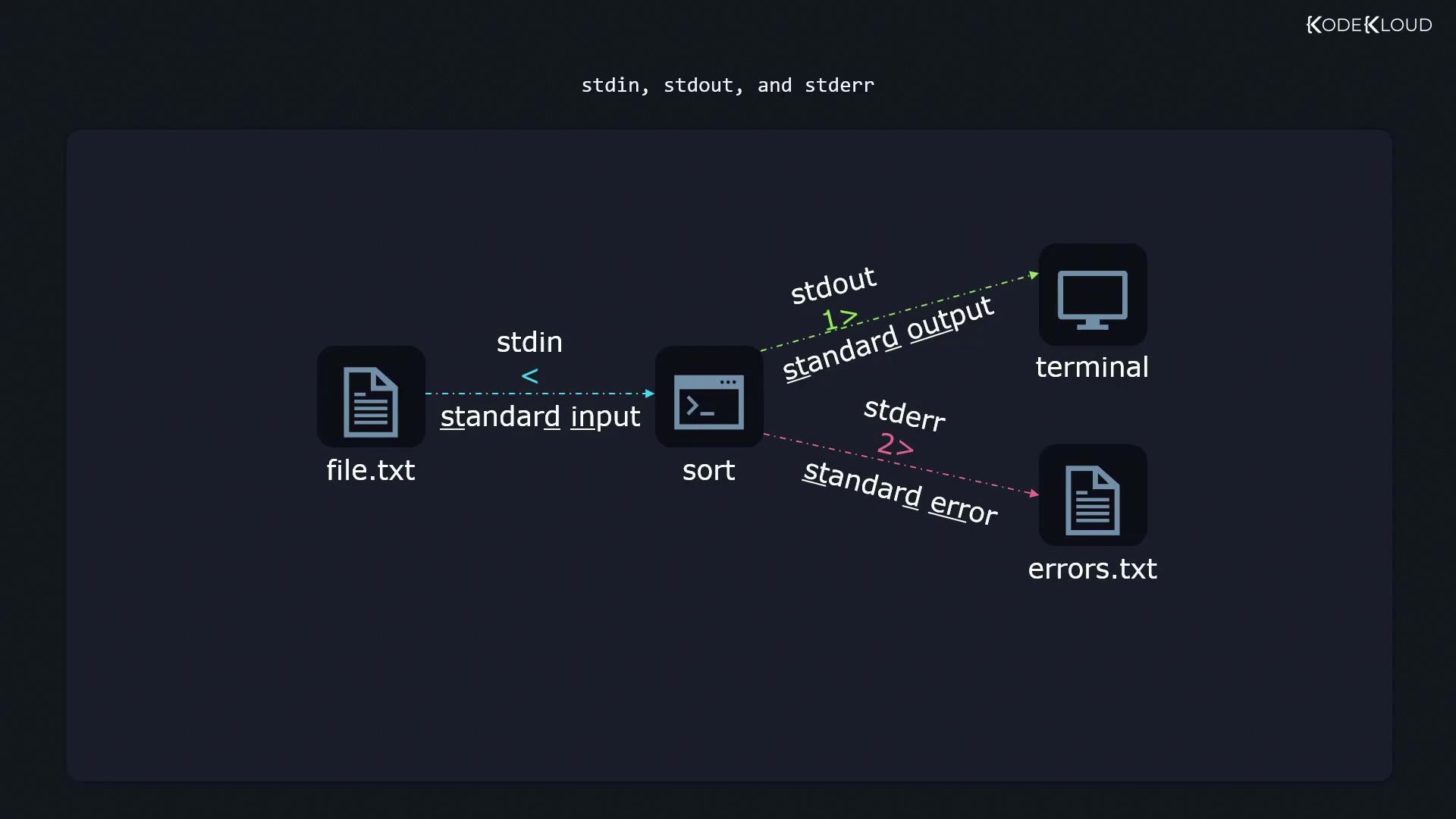Linux System Administration for Beginners
Essential Commands
Use input output redirection
This guide shows how to manage standard input, output, and error streams in Linux. You’ll learn how to redirect data between commands, files, and devices to build powerful command-line workflows.
Default Input and Output
Most Linux utilities read from files or stdin and write to stdout by default. For example, the sort command orders lines of text:
$ cat file.txt
6
5
1
3
4
2
$ sort file.txt
1
2
3
4
5
6
By default, sort reads from file.txt, sorts the lines, and sends the result to your terminal.
Redirecting Standard Output (>)
Use the > operator to save a command’s output to a file. The target file is created if it doesn’t exist or overwritten if it does:
$ sort file.txt > sortedfile.txt
$ cat sortedfile.txt
1
2
3
4
5
6
Each time you run:
$ date > file.txt
the contents of file.txt are replaced by the new output.
Warning
Redirecting with > will overwrite existing files without prompt. Always double-check your filename to avoid data loss.
Appending Standard Output (>>)
To append data instead of overwriting, use >>:
$ date >> file.txt
$ date >> file.txt
$ date >> file.txt
$ cat file.txt
Mon Nov 8 18:50:30 CST 2021
Mon Nov 8 18:50:31 CST 2021
Mon Nov 8 18:50:32 CST 2021
Standard Streams Overview
Every Linux process has three standard streams:
| Stream | Descriptor | Description |
|---|---|---|
| stdin | 0 | Input (keyboard, files, pipes) |
| stdout | 1 | Standard output (terminal, files) |
| stderr | 2 | Error messages |

Note
By default, both stdout and stderr appear on your terminal. You can redirect each stream independently to capture output or suppress errors.
Redirecting Standard Error (2>)
Send error messages to a file (or discard them) by prefixing the redirection operator with 2:
$ grep -r '^The' /etc/
grep: /etc/cups/ssl: Permission denied
...
$ grep -r '^The' /etc/ 2>/dev/null
/etc/brltty/Input/tn/all.txt: The two keys at the left rear (2 columns, 1 row):
...
Here, 2>/dev/null discards all errors by sending them to the null device.
Capturing Both stdout and stderr
To redirect both streams:
# Separate files
$ grep -r '^The' /etc/ 1>output.txt 2>errors.txt
# Append instead of overwrite
$ grep -r '^The' /etc/ 1>>output.txt 2>>errors.txt
# Merge stderr into stdout
$ grep -r '^The' /etc/ > all_output.txt 2>&1
Redirecting > first sends stdout to all_output.txt, then 2>&1 points stderr at the same destination.
Redirecting Standard Input (<)
Feed a file as input using <:
$ sort < file.txt
1
2
3
4
5
6
For commands that expect interactive input (e.g., sendmail), supply a file:
$ sendmail [email protected] < emailcontent.txt
Here Documents
Embed multiline input directly in a script with a here document:
$ sort <<EOF
6
3
2
5
1
4
EOF
1
2
3
4
5
6
The shell reads stdin until it finds the terminating EOF marker.
Here Strings
Use a here string (<<<) for single-line input:
$ bc <<< "1+2+3+4"
10
Piping Between Commands
Chain commands with the pipe operator |, which sends stdout of one command to stdin of the next:
$ grep -v '^#' /etc/login.defs \
| sort \
| column -t
Example output:
CREATE_HOME yes
ENCRYPT_METHOD SHA512
GID_MAX 60000
GID_MIN 1000
... (and so on)
Pipes let you build complex data transformations by combining simple utilities.
Redirection Operators Summary
| Operator | Stream | Description |
|---|---|---|
| > | stdout (1) | Redirect & overwrite output |
| >> | stdout (1) | Redirect & append output |
| 2> | stderr (2) | Redirect & overwrite errors |
| &> | stdout (1) and stderr (2) | Redirect both to the same file |
| < | stdin (0) | Redirect input from a file |
| <<EOF | stdin (0) | Here document (multiline stdin) |
| <<< | stdin (0) | Here string (single-line stdin) |
Links and References
Watch Video
Watch video content
Practice Lab
Practice lab